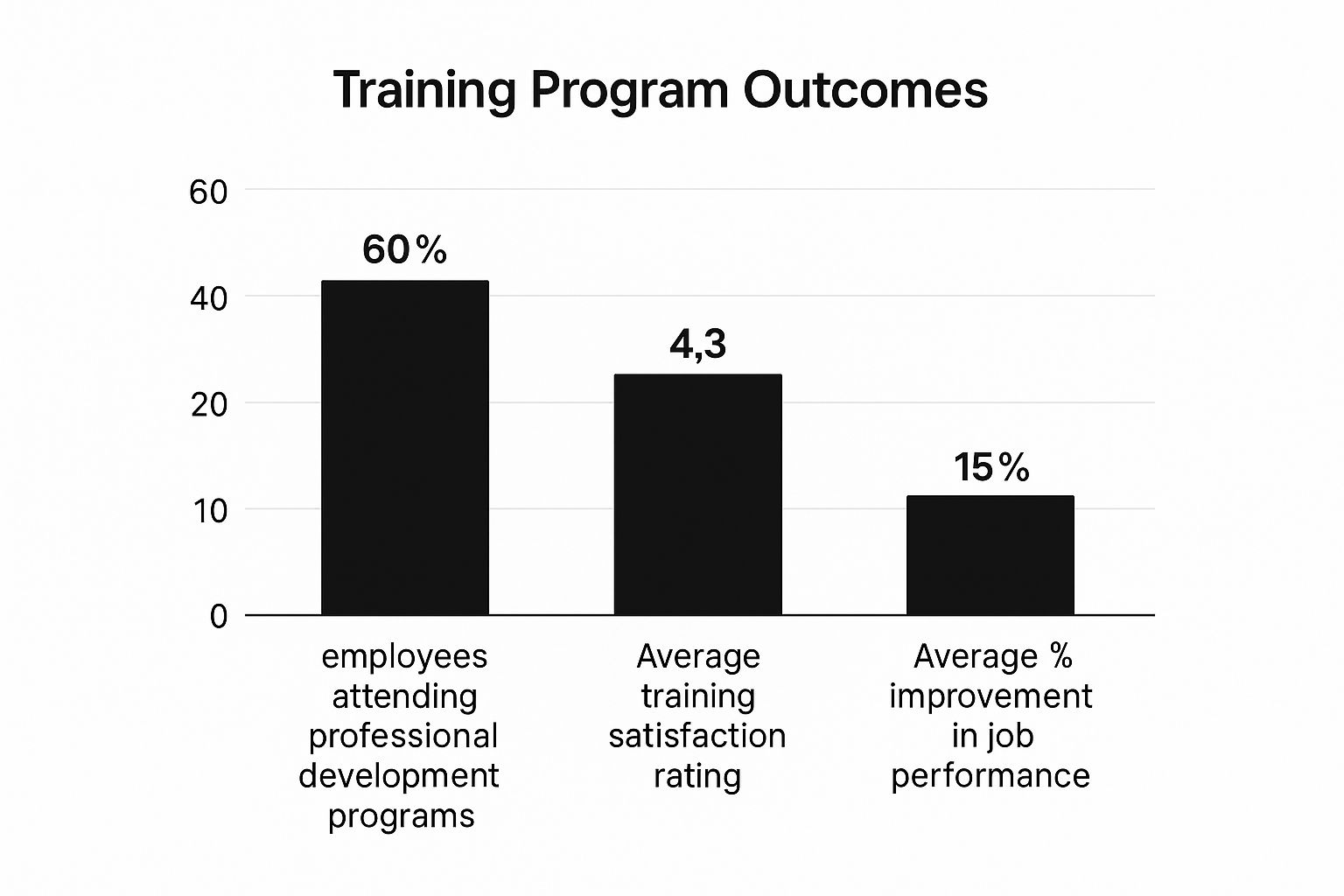Improving employee morale isn’t just about surface-level perks. It’s a much deeper game, one that requires a real strategy built on genuine recognition, supportive leadership, and providing meaningful growth opportunities. When you nail this, you create a workplace where people feel valued and connected—and that directly fuels engagement, productivity, and loyalty.
Why Employee Morale Is a Business Imperative
Let's cut to the chase: great employee morale is more than a fluffy, feel-good metric. It's a hard indicator of your company's health and a critical piece of any long-term success story. When your team feels good about their work, they're more collaborative, innovative, and tough enough to handle challenges. But when morale starts to slide, the fallout can be felt across the entire organization.
Low morale isn't just a few grumpy faces in the hallway. It shows up as real, tangible business problems that can quietly eat away at your bottom line. Think of your team as an engine. If it’s running on low oil, performance sputters, parts wear out, and a breakdown becomes inevitable. The same is true for a disengaged team.
The Real-World Consequences of Low Morale
When people feel undervalued or disconnected, their drive simply disappears. This leads to some serious issues you can't afford to ignore:
- Lagging Productivity: An unmotivated employee isn't going to give that extra 10%. Deadlines start to slip, the quality of work dips, and the entire pace of progress slows down.
- Higher Turnover: It's no secret that people leave jobs where they don't feel appreciated. In fact, a staggering 63% of workers who quit point to a lack of career growth as a major reason. The cost to replace them is huge—often 100-150% of their annual salary when you factor in recruitment and training.
- A Decline in Creative Thinking: Innovation thrives in a positive, psychologically safe environment where people aren't afraid to take risks. When morale is low, that fear creeps in and chokes out the very creative thinking you need to solve problems and grow.
Low employee morale is a silent productivity killer. It doesn't show up on a balance sheet until it’s too late, manifesting as missed deadlines, increased absenteeism, and a revolving door of talent.
Reframing Morale as a Strategic Priority
Boosting morale isn’t about installing a ping-pong table or throwing a single holiday party. It’s about building a culture where people consistently feel seen, heard, and respected. This guide will break down how to actually do that by fostering recognition, cultivating strong leadership, and creating real opportunities for growth.
Shared experiences, even simple ones like a team meal, can make a huge difference. For instance, many companies are finding that choosing the right cuisine for corporate events can build connections and show appreciation in a very tangible way. By making morale a true priority, you're not just investing in your team’s happiness—you're making a smart investment in your company’s future.
Build a Culture of Genuine Recognition

Let's be honest, the old "employee of the month" plaque is a tired tradition. If you really want to move the needle on morale, you need to build a culture where genuine recognition is woven into your company's DNA. This isn't about grand, once-a-year gestures. It’s about consistently and authentically acknowledging the hard work, clever ideas, and daily efforts your team delivers.
When appreciation is specific and timely, it lands with real impact. It validates an employee's contribution and provides a powerful boost of motivation. Shifting from sporadic awards to continuous, meaningful feedback shows your team that you're paying attention to the details, not just the big, flashy project completions.
It sounds simple, but this is a seriously underused strategy. Think about it: research shows only 30% of employees feel they get regular recognition at work. What's more, team members who feel unappreciated are twice as likely to quit within the year. A 2024 survey of Silicon Valley companies even found that those with structured, frequent recognition programs saw 20% higher retention rates. The data is clear—this stuff works.
Make Recognition Specific and Timely
Vague praise just doesn't cut it. "Good job" is nice, but it's forgettable. The most effective recognition is immediate and details exactly what was done well and why it mattered.
For instance, instead of a quick "thanks," a manager could say, "Sarah, the way you reorganised the client data in that spreadsheet was a game-changer. You saved the team at least three hours this week. That was a brilliant and proactive solution." See the difference? That kind of specific feedback shows you’re truly engaged with their work.
Another great tool is the "spot award." This is a small, on-the-spot reward for someone who solves a tricky problem or goes the extra mile. It could be a gift card, an extra half-day off, or even just treating the team to a catered lunch. The immediacy makes the reward feel directly connected to the valued behaviour.
Key Takeaway: The goal is to make recognition a natural part of your daily operations. When appreciation becomes a regular part of the conversation, it stops feeling like a formal HR process and starts feeling like a genuinely supportive culture.
Empower Peer-to-Peer Appreciation
Recognition shouldn’t just come from the top down. Some of the most meaningful praise comes from the people we work with every day. When you empower employees to celebrate each other's wins, you build incredible camaraderie and shine a light on contributions that managers might otherwise miss.
Here are a few practical ways to make this happen:
- Use a Digital Shout-Out Channel: If you use a tool like Slack, create a dedicated channel where team members can give public "kudos" to colleagues. It creates a live, positive feed of appreciation that everyone can see.
- Create a Physical 'Wins' Board: It might seem low-tech, but a simple whiteboard in a common area can be incredibly powerful. Anyone can grab a marker and write a quick thank-you or celebrate a coworker's success.
- Kick Off Meetings with Praise: Start your weekly team huddles with a quick round-robin where everyone shares a personal win or thanks a colleague who helped them out.
These small, consistent acts compound over time. Even simple gestures, like celebrating team milestones with buffet-style office catering, create shared memories that strengthen bonds.
To take it a step further, look into employee appreciation gift ideas that truly resonate and show your team you genuinely value them. By building a recognition culture from multiple angles, you create an environment where everyone feels seen, valued, and motivated to do their best work.
Cultivate a Supportive and Healthy Work Environment

Great morale doesn't just happen. It’s cultivated, and it starts with the environment you create for your team every single day. A workplace that truly champions both physical and psychological well-being is one of the most powerful tools you have for boosting spirits and performance. This isn't about surface-level perks; it's about embedding support into the very fabric of your company culture.
Let’s start with the physical space. A cluttered, noisy, or badly lit office is more than just an annoyance—it's a constant, low-grade stressor that drains energy. Think about how your current layout serves different work styles. While an open-plan office might spark collaboration for some, it can be a nightmare for others who need quiet to focus.
The best workplaces offer a mix. Think small pods for private calls, comfy lounge areas for informal chats, and dedicated quiet rooms for deep work. Even simple things like investing in good lighting and proper ergonomic chairs send a powerful message: we care about your health and comfort.
It's All About Psychological Safety
A comfortable office is a great start, but what really holds a team together is psychological safety. It’s that shared feeling that you can speak up, suggest a wild idea, or even admit a mistake without fear of being shut down or shamed.
When people don't feel safe, they stay silent. Innovation stalls because no one wants to rock the boat. On the flip side, a psychologically safe workplace is built on trust, encouraging the kind of vulnerability that lets high-performing teams thrive.
Key Insight: A truly supportive environment isn’t about adding more perks; it's about removing fear. When your team feels safe enough to be themselves, their creativity, collaboration, and commitment will skyrocket.
Leaders set the tone here. When you admit you don't have all the answers or own up to a mistake, you give your team permission to do the same. That one simple act can completely shift the dynamic, turning your culture into one of continuous learning and growth.
Champion Mental Wellness and a Healthy Work-Life Balance
A supportive culture must also actively champion work-life balance and mental health. Burnout is a silent killer of morale and a fast track to high turnover. You need clear policies that don't just allow but encourage your people to disconnect and recharge.
This means:
- Setting Clear Boundaries: Make it company policy to discourage after-hours emails and messages. When the day is done, it's done.
- Promoting Mental Health Resources: Ensure your team knows about any available resources, like an Employee Assistance Program (EAP). More importantly, work to destigmatize conversations around stress and mental health.
In California, this is becoming law. Starting in 2025, new regulations will require health insurance plans to cover mental health on par with physical health. This is a huge deal, especially when a 2023 study found that nearly 40% of Californians with employer-provided insurance struggled to get the mental health care they needed.
Ultimately, a healthy work environment is holistic. It considers everything from the office layout to your team's emotional well-being. Even simple gestures, like providing catering for warehouse staff during busy seasons, can show your appreciation in a tangible way that relieves stress. By building this supportive foundation, you create a workplace where morale doesn't just survive—it thrives.
Foster Connection Through Shared Experiences

Strong teams are built on real relationships. But let's be honest, you can't force connection with awkward, mandatory team-building exercises. The real secret to boosting morale lies in creating chances for genuine, shared experiences where people can just be people, not job titles.
These are the moments that build the trust and camaraderie every positive workplace needs to thrive.
One of the oldest and most effective ways to make this happen? Simply breaking bread together. Sharing a meal is a universal experience. It naturally lowers barriers and gets people talking, transforming workplace dynamics from purely transactional to genuinely collaborative.
The Power of a Shared Meal
Think about the last time you had a great meal with friends. The conversation just flowed, didn't it? You felt relaxed and connected. Bringing that same energy into the office can be a game-changer. It creates a built-in break where your team can actually step away from their screens and engage on a personal level.
Something as simple as a catered weekly lunch provides a consistent, reliable opportunity for this to happen. It's more than just a perk; it's a direct investment in your company culture.
These meals help dissolve the invisible walls that often exist between departments and even management levels. All of a sudden, a developer is chatting with someone from marketing, and a junior team member feels comfortable asking a senior leader about their weekend.
A shared meal is a simple but powerful catalyst for community. It creates a space where informal mentorship, spontaneous brainstorming, and genuine friendships can begin to form, strengthening the entire organisation.
This simple act shows your team you’re invested not just in their work, but in their well-being and in building a supportive environment for everyone.
Ideas for Fostering Connection
Beyond a simple lunch, you can get creative with food and other activities to build even stronger bonds and celebrate what makes your team unique. These shared experiences become the stories people tell for years and the memories that knit them together.
Here are a few practical ideas I've seen work wonders:
- Themed Food Days: Celebrate the diverse backgrounds on your team by organising catered lunches featuring different global cuisines. It’s a fantastic way to make everyone feel seen, included, and valued.
- Collaborative Passion Projects: Set aside time for cross-departmental teams to tackle a fun, low-stakes project outside of their normal duties. This could be anything from organising a charity drive to planning a company-wide social event.
- Team Volunteer Days: Nothing builds bonds quite like working together for a cause you all believe in. It connects your team to the wider community and reinforces a shared sense of purpose beyond the bottom line.
Initiatives like these shift the focus from individual tasks to collective achievement and connection. When you thoughtfully create these opportunities, you build a workplace where people feel like they truly belong—and that’s where a natural, sustainable boost in morale comes from.
Empower Your Team with Autonomy and Growth
There's no faster way to crush morale than letting your team feel like they're spinning their wheels. When people feel stuck, with no clear path forward, their motivation and engagement take a nosedive. The single most powerful thing you can do to boost morale is to invest in their future and trust them with the present.
This all comes down to building a culture centred on two things: personal autonomy and professional growth.
Giving your team autonomy isn't about just letting go of the reins; it's about delegating real ownership. Think of the difference between assigning a list of tasks versus entrusting a project to someone from start to finish. Showing that level of trust sends a clear message: "I value your judgment and I believe in your skills." This can look like letting a team lead manage their own project budget or offering flexible work arrangements that empower people to work when and where they're most productive.
Create Clear Pathways for Career Development
Think about this: a staggering 63% of employees who quit their jobs point to a lack of career advancement opportunities as a major reason. People need to see a future for themselves within your company. If they can’t, they'll start looking for one somewhere else.
It's crucial to create transparent career paths that go far beyond a once-a-year review. Here are a few practical ways to do this:
- Launch a Mentorship Program: Pairing experienced employees with newer team members is a fantastic way to share institutional knowledge, build connections, and give junior staff a go-to person for guidance.
- Offer a Dedicated Training Budget: Set aside real funds for people to attend workshops, earn certifications, or take online courses. This shows you're truly invested in them sharpening their skills, not just checking a box.
- Schedule Regular Career Conversations: Managers should be proactively talking about career goals with their direct reports multiple times a year. Don't wait for the annual review to ask what they want to achieve.
The most engaged employees are those who feel their company is invested in their personal success, not just their immediate output. Growth opportunities are a tangible sign of that investment.
The connection between providing these opportunities and seeing a real return in performance is undeniable.

As you can see, when people participate in training programs, their satisfaction and performance get a significant lift.
This table breaks down how specific initiatives can directly influence the vibe and productivity of your team.
Impact of Growth Initiatives on Morale
| Initiative | Primary Impact on Morale | Implementation Tip |
|---|---|---|
| Mentorship Program | Boosts feelings of support and belonging, reducing isolation. | Pair mentors and mentees based on career goals and personality, not just job titles. Provide a light structure but allow the relationship to develop organically. |
| Skill-Based Training | Increases confidence and competence, leading to higher job satisfaction. | Survey your team to identify the skills they're most eager to learn. This ensures the training budget is spent on what actually matters to them. |
| Clear Career Ladders | Replaces uncertainty with a clear, motivating vision for the future. | Don't just list titles. For each level, detail the specific skills, behaviours, and accomplishments required to get there. Make it a roadmap, not a mystery. |
| Internal Mobility Options | Shows that growth doesn't always have to be linear; it keeps talent in-house. | Create a simple internal job board and encourage managers to champion their team members for roles in other departments. |
Putting these ideas into practice transforms the workplace from a place where people just work to a place where they can truly grow.
A Real-World Example of Growth in Action
I once worked with a tech start-up that was struggling with high turnover among its junior developers. We dug into the exit interview feedback, and the story was always the same: they felt like they were just churning through coding tickets with no real sense of direction.
So, the leadership team created a detailed skills matrix.
This wasn't just a list of job titles. It was a clear, transparent roadmap that outlined the specific technical skills and soft skills someone needed to master to advance from a Junior Developer to a Mid-Level, and then to a Senior role.
The results were incredible. Within a single year, turnover in that department was slashed by over 40%. The developers finally had a tangible guide showing them exactly what they needed to learn to get ahead. They felt empowered, and their morale shot through the roof because the company gave them a clear, achievable vision for their future.
Answering Your Questions About Boosting Morale
When you're trying to figure out how to improve your team's morale, a few common questions always seem to pop up. It's easy to get bogged down by the "hows" and "what ifs." Let's tackle some of the most frequent hurdles managers face and give you some clear, practical answers to help you move forward.
The first question is almost always about the budget. Many leaders think that boosting morale is an expensive venture, but I've found that's rarely the case. In fact, some of the most effective strategies don't cost a dime. Think about creating a peer-to-peer recognition channel on Slack or just starting your meetings with a quick round of appreciation. These things are totally free.
The most powerful morale boosters are often rooted in culture, not cash. Consistent recognition, transparent communication, and showing genuine trust cost nothing but deliver substantial returns in engagement and loyalty.
How Can We Measure Morale Effectively?
Measuring something as intangible as morale can feel a bit like trying to catch smoke, but it's crucial if you want to know what's actually working. Employee engagement surveys are a fantastic starting point, giving you both hard numbers and the stories behind them. But a survey is just the beginning—the real magic happens when you act on what you learn.
Consider this: a national HR.com report found that over 40% of employees are disengaged. That's a huge number. But the data also shows that simply responding to feedback makes a real difference. In a 2024 municipal survey, for example, Los Angeles city departments that actually addressed employee feedback saw their morale scores jump by 12% in just 18 months. This drives home a key point: you have to close the feedback loop. Share the results, good or bad, and lay out a clear plan for what comes next. You can find more details about how California is using employee engagement surveys to create positive change.
What If My Team Is Skeptical?
It’s completely normal for teams, especially long-standing ones, to be a little suspicious of new initiatives. If past efforts fizzled out, they have every right to be wary. When you run into skepticism, your best friends are transparency and consistency. Be upfront that you’re trying something new and, most importantly, explain why you're doing it.
Here’s how to handle it:
- Start Small: Don't overwhelm everyone with five new programs at once. Choose one or two simple things with a big impact, like a catered team lunch, and stick with it.
- Ask for Input: Pull a few of your informal team leaders into the planning. When people feel like they have a say in the process, they're far more likely to get on board and encourage others.
- Be Patient: You can't rebuild trust or shift a culture overnight. It takes time. Just stay consistent, and the positive changes will start to win over even the toughest critics.
If you're looking for a deeper dive, exploring various ways to improve employee morale can give you even more ideas to try. At the end of the day, showing your team you're genuinely committed to making their work environment better is the most powerful thing you can do.
At Shawarma Moose, we know that a shared meal is one of the easiest and most effective ways to build connection and show appreciation. Let us help you boost morale with our delicious, stress-free corporate catering solutions. Explore our customizable catering menus today

